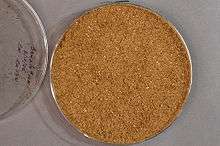Meat and bone meal

Meat and bone meal (MBM) is a product of the rendering industry. It is typically about 48–52% protein, 33–35% ash, 8–12% fat, and 4–7% moisture. It is primarily used in the formulation of animal feed to improve the amino acid profile of the feed. Feeding of MBM to cattle is thought to have been responsible for the spread of BSE (mad cow disease). In most parts of the world, MBM is no longer allowed in feed for ruminant animals. However, it is still used to feed monogastric animals.
MBM is widely used in the United States as a low-cost meat in dog food and cat food.[1] In Europe, some MBM is used as ingredients in petfood but the vast majority is now used as a fossil-fuel replacement for renewable energy generation, as a fuel in cement kilns, landfilling or incineration. Meat and bone meal has around two thirds the energy value of fossil fuels such as coal; the UK in particular widely uses meat and bone meal for the generation of renewable electricity. This was particularly prominent after many cattle were slaughtered during the BSE crisis. Meat and bone meal is increasingly used in cement kilns as an environmentally sustainable replacement for coal.
Types
Meat meal: Powder obtained by cooking, defatting, sterilizing, grinding, and sifting by-products of terrestrial animals. This denomination includes both meat and bone meal (MBM) and meat meal in the strict sense, less rich in minerals than MBM; it is often referred to as "processed animal protein"[2].
Bone meal: It is produced with bones (of terrestrial animals) of second quality. The other bones can be used beforehand for the manufacture of gelatin and / or treated to produce dicalcium phosphate or ossein powder; the meal is produced by heating, defatting, drying, grinding and sieving the bones of terrestrial animals[2][3].
Meal from skin appendages: horns, hooves and nails (around 55,700 tons per year in France[4]) are used for example in agricultural or garden fertilizers for their sulfur, nitrogen and phosphorus contents, or used in the composition of meat meal.
Blood meal: fresh and whole blood collected from slaughterhouses, coagulated and steam dried now often referred to as "animal protein transformed from blood".
Feather meal: (Fresh feathers from slaughterhouses, treated by thermal hydrolysis (chemical decomposition in the presence of pressurized water), dried and crushed.
Categories
In Europe (before the 2002 EU Regulation), animal by-products were classified into two categories: "high risk" or "low risk" products.
Since 2002, "processed animal protein" (PAP) and other animal by-products; authorized or not for various uses are categorized into three categories (by the European Regulation 2002) according to their supposed or demonstrated level of health risk.
- Category 1 material: those that pose a risk to TSEs ("prion-risk" meat), including "SRM" ("specified risk material") and animals suspected or declared to be infected with EST[5]). This category also contains products contaminated by certain banned substances (hormones) or dangerous for the environment (dioxins).
- Category 2 materials: associated with a health risk to animal zoonoses and diseases other than TSEs. There are also foodstuffs seized for sanitary reasons and corpses of animals who died by other means than by being slaughtered, or products contaminated with residues of veterinary drugs.
- Category 3 material; they come from animals considered healthy and without specific risks, that is to say the carcasses have been declared fit for human consumption after health inspection. Only products in this category are allowed for the production of flours for animal feed (including pets)[2]
See also
References
- ↑ http://www.pedigree.com/really-good-food/product-page.aspx?id=1058&prevPage=adult
- 1 2 3 SIFCO (Syndicat des Industries Françaises des Coproduits animaux ; Syndicat interprofessionnel regroupant les transformateurs de coproduits animaux en protéines et graisses animales), Lexique [archive]
- ↑ Les farines de viandes osseuses (FVO) et les concentrés protéiques carnés (CPC) [archive], École nationale vétérinaire de Lyon
- ↑ Sénat, Projet de loi relatif à la collecte et à l'élimination des cadavres d'animaux et des déchets d'abattoirs et modifiant le code rural [archive] ; Travaux parlementaires > Rapports > Rapports législatifs, consulté 2013-09-09
- ↑ Encéphalopathies spongiformes transmissibles (parfois dénommées Encéphalopathies spongiformes subaiguës Transmissibles ou ESST) ; famille de maladies neurodégénératives des animaux incluant notamment l'ESB et la tremblante
- Adedokun, S. A.; Adeola, L. (2005). "Metabolizable energy value of meat and bone meal for pigs". J. Anim. Sci. 83 (11): 2519–2526.
- Fernando, T. (1992). Blood meal, meat and bone meal and tallow. In Inedible meat by-products. Essex, England: Elsevier Science. pp. 81–112.
- Hendriks, W. H., C. A. Butts, D. V. Thomas, K. A. C. James, P. C. A. Morel and M. W. A. Verstegen (2002). "Nutritional quality and variation of meat and bone meal". Asian Austral. J. Anim. 15 (10): 1507–1516.
- Pearl, G. G. (2004). "Meat and bone meal usage in modern swine diets". Render. 33 (2): 50–53, 57.
- Taylor, D. M.; Woodgate, S. L. (2003). "Rendering practices and inactivation of transmissible spongiform encephalopathy agents". Rev. Sci. Tech. OIE. 22 (1): 297–310.
External links
- PDM Group Information on the use of meat and bone meal for renewable power generation.